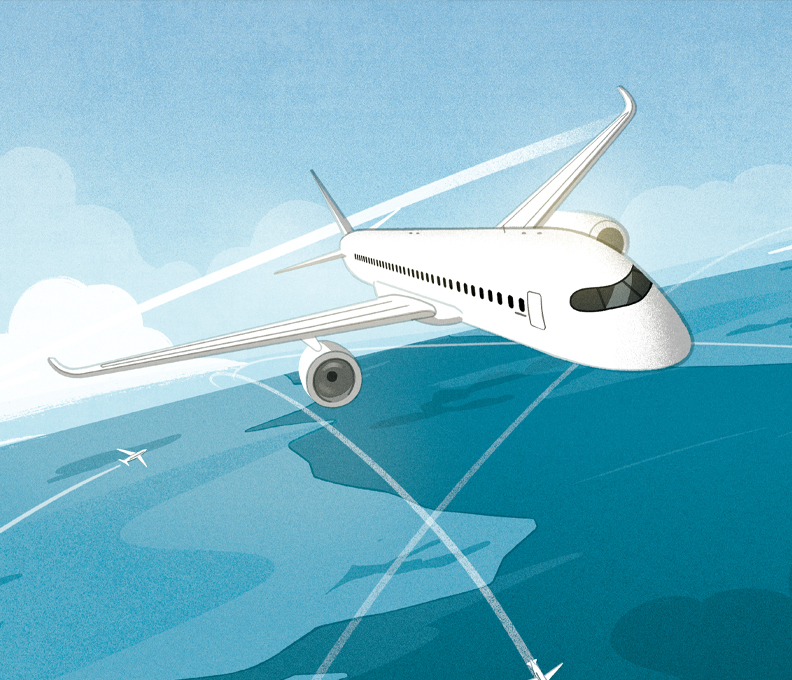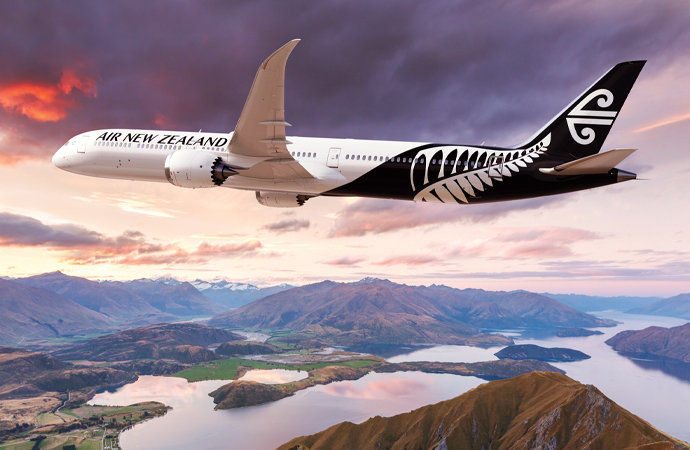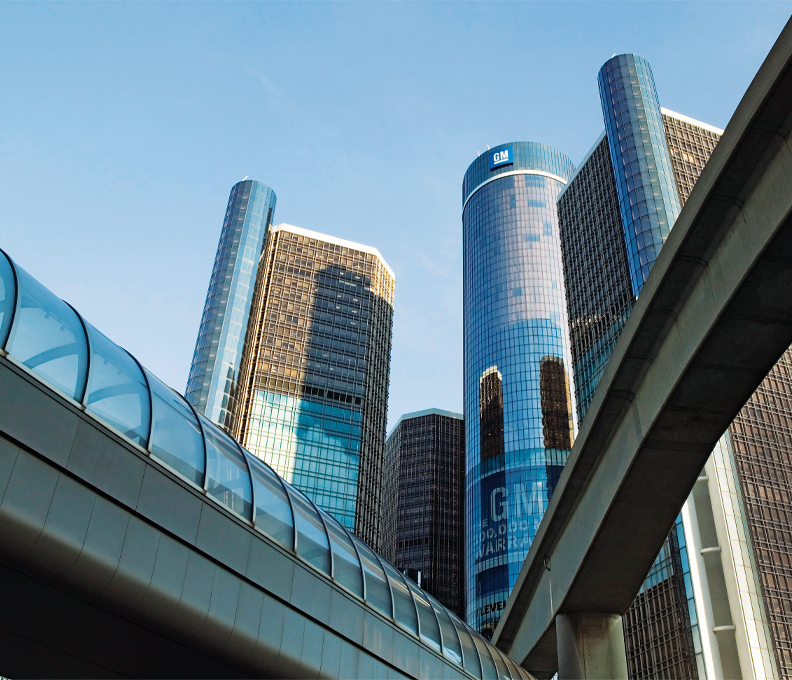The Future of Ultra-Long-Haul Flights
New aircraft are making longer flights increasingly available. How airlines are handling the possibilities—and what it means for passengers
July 6, 2023

Illustration: Yo Hosoyamada
The advanced technology of new aircraft such as the Boeing 787 Dreamliner and Airbus A350 give airlines more flexibility than ever before. Not only can they use the aircraft on routes that don’t require the larger seat capacity, but they can also fly farther without cannibalizing the passenger or cargo volume. This opens dozens of new possibilities to fly ultra-long-haul flights to every corner of the globe.
However, what’s good for airlines may not always be good for passengers. After all, spending 18 hours on a flight can be taxing to both the body and mind. Sitting in a seat for extended periods of time can be detrimental to your health, and the effects of jet lag can be brutal. Still, the demand for these flights is strong, and the time saving of avoiding changing planes can be substantial.

Air New Zealand launched nonstop flights from Auckland to New York-JFK and Chicago using its Boeing 787-9 Dreamliners / Photo: Courtesy of Matteo Colombo
Connecting the globe
As airlines acquire more aircraft capable of flying 8,000 miles at a time, they add more routes to their network. Most famous are the longest flights in the world, both operated by Singapore Airlines from New York-JFK and Newark to Singapore. Qatar Airways and Emirates also offer lengthy flights, with the former operating between Doha and Auckland—its longest scheduled flight at more than 9,000 miles.
American Airlines and United fly from New York to India, with the return journey taking approximately 16 hours. United, especially, is no stranger to ultra-long flights, operating routes like Houston-Sydney and San Francisco-Singapore, among others. The options continue to grow.
Patrick Quayle, senior vice president of global network planning and alliances for United Airlines, says there are always potential route opportunities. Among the things they consider is competition on the route from other airlines, the number of local passengers traveling from either city, airport slot availability, how much connecting traffic is needed to make the route work, and the length of the flight. After all, the longer the flight, the more aircraft resources the airline needs, which takes planes away from other routes.
The most famous routes come from Qantas and its Project Sunrise. Since 2017, it has used Dreamliners to fly between London-Heathrow and Perth, continuing to Sydney after a short stop. This is the first time the United Kingdom and Australia have been connected without a stop. And when the new Airbus A350-1000 planes arrive, Qantas will be able to fly from New York to either Sydney or Melbourne in one go.

Qantas will offer on its Project Sunrise Airbus A350-1000 six First Class suites, complete with a privacy door, separate bed, lounge chair, wardrobe and 32-inch entertainment screen / Photo: Courtesy of Qantas
Air New Zealand has beaten Qantas to the punch launching nonstop flights from New York-JFK to Auckland using its Dreamliners. But it must take a weight penalty on the flight bound for Auckland, as headwinds force it to carry fewer passengers, bags and cargo—something many airlines consider when deciding when and where to fly a route.
Qatar Airways says other factors are also at play when deciding which routes to fly. For example, it depends on available aircraft in the fleet, market demand (both passengers and cargo), GDP of the destination, and overall network balance. A recent example of finally achieving that was making the switch from a one-stop flight to Auckland via Adelaide to two separate, nonstop long-haul flights from Doha.
Is it smart for your health?
If Project Sunrise is any indication, the demand for these nonstop flights is strong. Projected to start in 2025, Qantas will begin flying nonstop from Sydney to both London and New York. But that’s a long time to spend in one seat.
Fully aware of the difficulties long flights can pose to the body, airlines are doing their best to provide an onboard experience that is as comfortable as possible. For example, Singapore Airlines partnered with Golden Door spa in Southern California to design wellness food and beverage menus that are easy on digestion and promote rest. Other considerations for the ingredients were boosting circulation and hydration while focusing on energy levels upon arrival.
The layout of these aircraft is leaner, too. This should provide more space for passengers, a key to stretching, moving and staying comfortable. The Qantas A350-1000 aircraft is expected to carry 238 passengers instead of the maximum of 480, which the aircraft could carry in an all-economy layout.
Qantas tapped into research from doctors and psychologists to assist in designing the onboard experience. It also hired interior designers to give these planes an upmarket feel. A new feature is the well-being zone—a dedicated space where people can relax and stretch away from their seats. It will have a self-serve snack station as well as digital displays providing stretching and movement exercise recommendations.
Realizing the demand for premium cabin seats, the Qantas A350s will have First, Business and Premium Economy cabins, which will comprise almost half of the aircraft’s capacity. First class suites will have a separate seat and bed, and Business class will have all-aisle direct access behind a sliding privacy door. While the planes will use 20-percent less fuel and emit 25 percent of the CO2 emissions of older planes, that doesn’t provide much comfort to passengers on a flight that can take as long as 20 hours.
But is it bad for your health? Dr. Michael Breus, PhD and founder of thesleepdoctor.com, says that jet lag on these flights (especially if not traveling in a lie-flat seat) can be rough. So beyond the usual recommendations to avoid alcohol and stay hydrated, he recommends passing up carbonated and spicy items and suggests sleeping more than usual the night before a big trip. Another tip: Avoid electronics, especially those that emit blue light, which can deter natural melatonin production. There is a way to fly long-haul and preserve your sanity and well-being, he says, if travelers prioritize certain behaviors.
Route to profitability
The excitement of faster travel may wane when sitting in an economy-class seat for 18 hours, albeit less so in business or first class. But no matter where you sit, airlines are doing a better job than ever of keeping passengers busy with entertainment systems and new choices for food and drink.
For example, Qatar Airways’ Doha-Auckland flight has a main meal after takeoff, one before landing, and midflight snacks. For Business Class passengers, the airline’s on-demand dining can take the sting out of traversing so many time zones, allowing passengers to choose when they eat and rest.
Carriers such as American Airlines and Singapore Airlines do not offer universal dine-on-demand options, and the disruption of meal service when you aren’t ready for it can affect sleep patterns. Don’t assume that if you’re landing at 6 p.m., the pre-arrival meal will be dinner. Many airlines serve breakfast before landing, even in the evening, because it more closely aligns with passenger body clocks from the takeoff point. (It is also a less expensive meal to prepare, say some catering managers.)
Some airlines spare no expense for onboard catering. Famous for their dining, Turkish Airlines and Qatar Airways invest a lot in in-flight meals, although neither carrier would disclose an exact amount. Qatar Airways makes fresh pasta, bread and omelets from scratch daily in its flight kitchens, even for Economy Class. Meals are loaded for every passenger, and extras are included for Business Class passengers to ensure everyone gets their top choice. Turkish Airlines, meanwhile, has onboard chefs who present meals on elaborate trolleys, with some dishes prepared to order.
But what happens at the last minute if more passengers are added to a flight, or some travelers pay for an upgrade? Flight kitchens consider this and have extra meals waiting to add to a plane. It would be inhumane to send a plane on an 18-hour journey without enough meals for everyone, and this saves flights from being delayed.
The scale of an airline’s onboard catering is immense. For example, Qatar Airways goes through 12 million liters of bottled water and 3.2 million bottles of white wine annually. According to the airline, the destination plays a role in what is loaded on a particular flight. More passengers consume tea on flights to China and India, so they must bring a higher amount. On flights to the U.S. and Australia, passengers drink more alcohol. Even the size of Business Class pajamas must be considered, given the difference in passenger demographics, with sizes on U.S. flights skewing larger.
Onboard amenities are crucial to a long flight, especially in business and first class. Items such as pajamas, amenity kits, pillows and blankets are carried, and on many routes, the airline may also carry what’s needed for the return flight in the cargo hold.
There are cost savings associated an airline doing its own laundry, and every little detail can exponentially impact flight profitability. For example, Qatar Airways cleans and folds almost 300,000 blankets per day at its in-house flight kitchen—the largest airline catering facility in the world. And then there’s the human element and aircraft usage to factor into the equation.
Given the time savings, airlines may be able to charge a premium for these nonstop flights. However, it must be consistently profitable given the more significant expense for fuel, crew and aircraft utilization. For example, a flight from New York to India requires two aircraft for an airline like American Airlines and United. With such long flight times, the flights in each direction are operating simultaneously. If a plane has a mechanical issue at a far-flung destination, sending another plane such a far distance can prove challenging, so sourcing local mechanics is vital.
These flights operate with two sets of pilots (so that two are flying while two are resting at any given time) and cabin crew. Therefore, these expenses must be factored into the profitability equation.
What is it really like?
Ultra-long-haul flying is undoubtedly an exciting development, especially for regions such as Australia, where passengers are accustomed to long flights. Highlighting the possibilities, Alan Joyce, chief executive officer and managing director for Qantas, says, “The A350 and Project Sunrise will make almost any city in the world just one flight away from Australia. It’s the last frontier and final fix for the tyranny of distance that has traditionally challenged travel to Australia.”
But ultra-long-haul flying may not be everyone’s cup of tea. Some passengers like breaking up a long journey with a stop between flights to stretch their legs, shower, or do some shopping or dining. However, business travelers may find this a worthy expenditure, especially if they can get solid rest in a private first or business class suite—it may be easier to get decent sleep than on a shorter transatlantic flight.
The seat will be king, though, and it’s hard to get that exactly right given the space and weight constraints on a plane. For example, some of the premium cabin seats for the new Project Sunrise A350 may be less than ideal.
The First class suite opts for a separate bed and lounge chair rather than a seat that transforms into a bed. This can limit the number of positions to recline or get comfortable. Passengers either sit mostly upright or lie down, which brings up the question if it justifies the high price. On the contrary, Business class offers a door and seat with many customizable positions.
It’s hard to please everyone, and for some, the ability to switch between seat and bed on a whim in First class may be their preference. For Gino Bertuccio—a Miami businessman and avid world traveler who has experienced numerous ultra-long-haul flights—these trips offer a unique atmosphere unlike any ordinary journey. The allure of these flights compels him to secure a business class seat to guarantee a comfortable and pleasurable experience.
“While on the flight, my routine consists of reading, watching movies, sleeping, eating and repeating. Surprisingly, I never felt agitated or eager to disembark from the plane,” Bertuccio says.
When asked about his preference between ultra-long-haul flights and those with an intermediate stop, Bertuccio says that nonstop flights are always the best choice. “The additional cost is worth it. An intermediate stop in a hub can disrupt your sleep patterns, and when you board the second flight, you must adjust again.”
And that brings us to loyalty programs. Do longer flights equate to more mileage earnings? Sadly, not anymore.
With many airlines switching to revenue-based frequent-flyer programs, an expensive flight in a premium cabin could add significant mileage earnings and a fast track to elite status. That may be more difficult if traveling in economy class, but some people may be able to attain the first tier of elite status with just one round trip.
There are benefits to earning elite status. Major U.S. airlines give their top-tier members upgrade certificates to apply on a space-available basis. If you’re like Bertuccio and want to fly up front on a long flight, achieving status may be a less expensive way to enjoy it—if you can find upgrade space, that is. If demand remains high, only those who start early and know how to look for deals will get lucky.
The Longest Flights in the World
Below are the longest currently operating flights in the world, according to frequent-flyer website Upgraded Points:
| 1. Singapore (SIN) to New York (JFK) | Singapore Airlines | 9,537 miles | 18 hours, 50 minutes |
| 2. Singapore (SIN) to Newark (EWR) | Singapore Airlines | 9,523 miles | 18 hours, 45 minutes |
| 3. Perth (PER) to London (LHR) | Qantas | 9,010 miles | 17 hours, 15 minutes |
| 4. Melbourne (MEL) to Dallas (DFW) | Qantas | 8,992 miles | 17 hours 35 minutes |
| 5. Auckland (AKL) to New York (JFK) | Air New Zealand | 8,828 miles | 17 hours, 50 minutes |
| 6. Dubai (DXB) to Auckland (AKL) | Emirates | 8,824 miles | 17 hours, 10 minutes |
| 7. Singapore (SIN) to Los Angeles (LAX) | Singapore Airlines | 8,770 miles | 17 hours, 50 minutes |
| 8. Bangalore (BLR) to San Francisco (SFO) | Air India | 8,701 miles | 17 hours, 40 minutes |
| 9. Darwin (DRW) to London (LHR) | Qantas | 8,620 miles | 17 hours, 55 minutes |
| 10. Houston (IAH) to Sydney (SYD) | United Airlines | 8,596 miles | 17 hours, 35 minutes |




